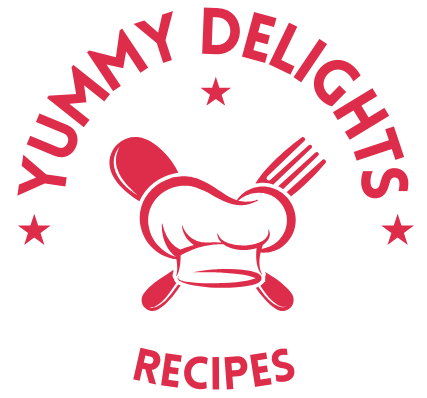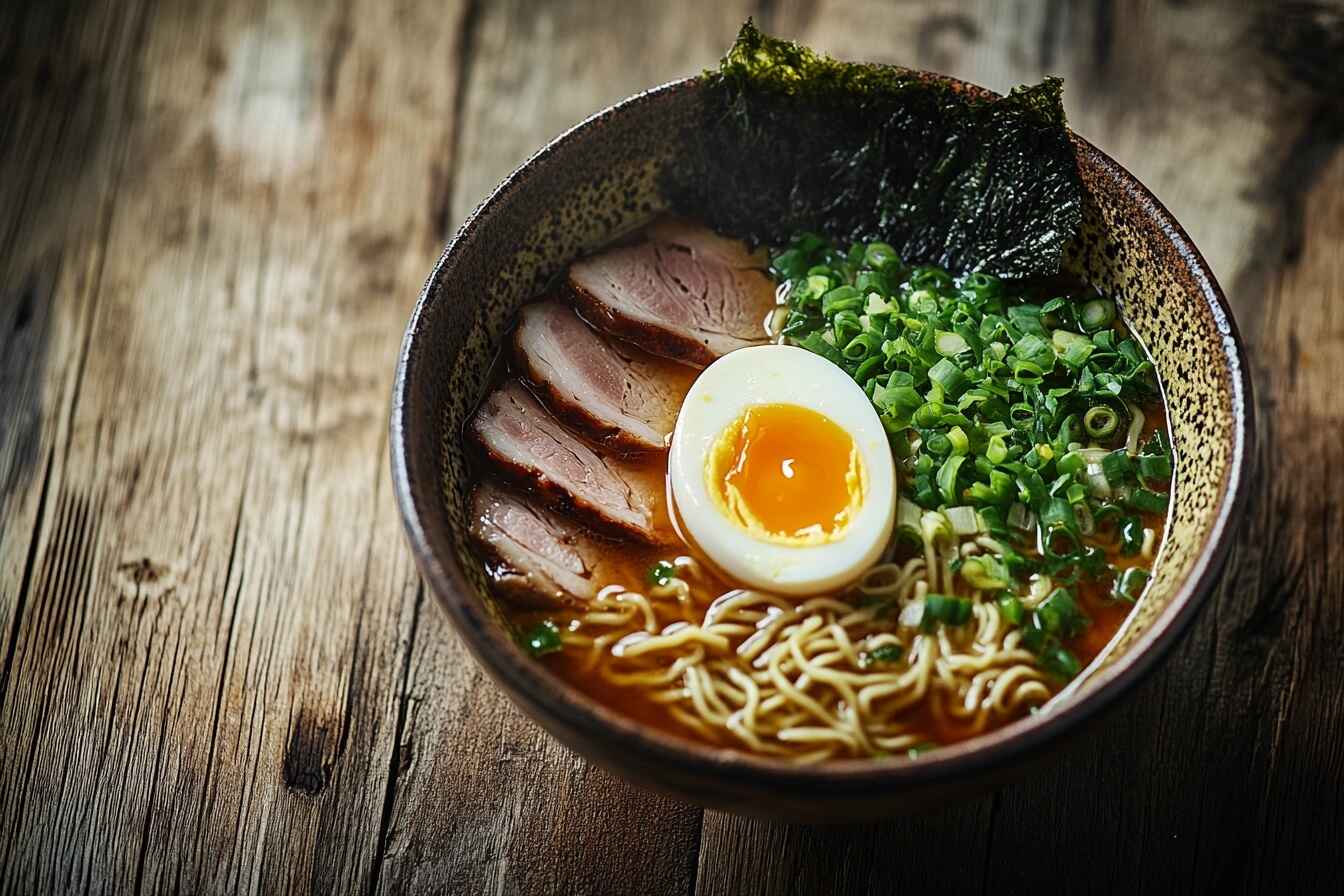Ramen – it’s one of those dishes that sparks instant nostalgia for late-night cravings or quick lunches. But here’s the million-dollar question: Is ramen a junk food? Whether you’re a fan of instant noodles or freshly made ramen bowls, this guide dives into the facts, myths, and solutions surrounding this iconic dish. Grab your chopsticks, and let’s dig in! 🍜
Understanding Ramen: A Popular Dish with Global Appeal
History and Origins of Ramen
Did you know that ramen’s roots trace back to China? That’s right! While it’s now a staple in Japanese cuisine, ramen originally came from Chinese wheat noodles. Japan adopted and adapted this dish in the early 1900s, adding their own unique broths and toppings. Fast-forward to today, ramen is a global phenomenon with countless variations.
Imagine this: steaming bowls of savory broth with chewy noodles topped with slices of tender pork, soft-boiled eggs, and seaweed. Sounds irresistible. While fresh ramen boasts this level of artistry, its instant cousin has a different story.
For those exploring quick and wholesome recipes, check out Ramen Noodle Bowl: The Ultimate Guide to Perfecting Your Bowl. It’s packed with tips for mastering this dish.
Table of contents
Types of Ramen: Instant vs. Fresh
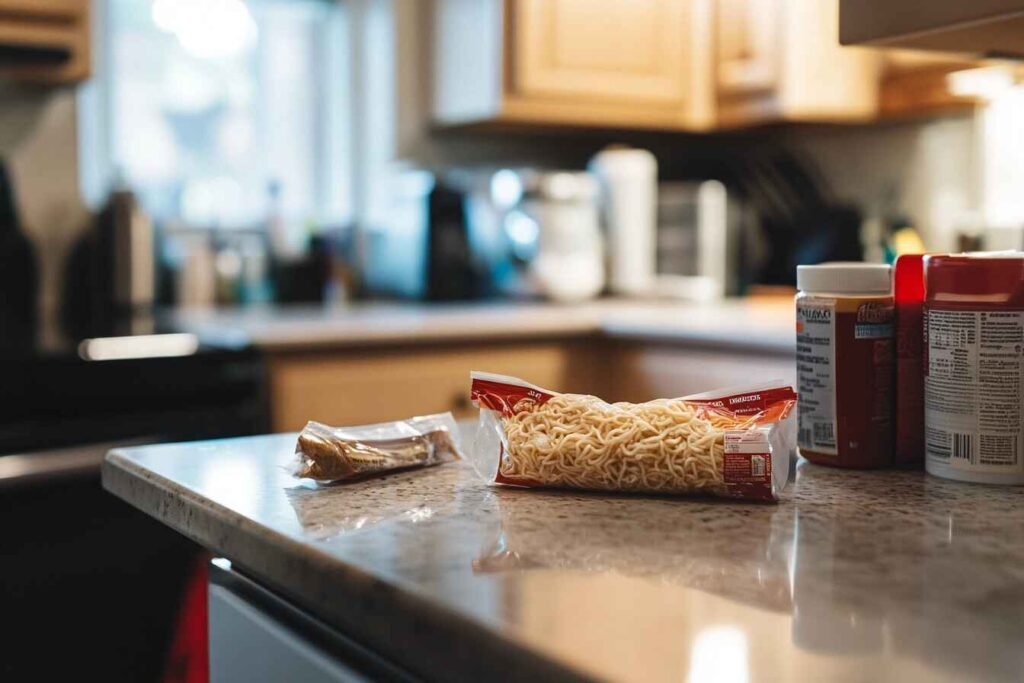
Let’s face it: instant ramen is the ultimate convenience food. It’s cheap, easy to make, and comes with a little packet of flavor magic. On the flip side, fresh ramen offers more depth – think handcrafted noodles, slow-cooked broths, and wholesome toppings.
| Aspect | Fresh Ramen | Instant Ramen |
|---|---|---|
| Preparation Time | Hours | 3–5 minutes |
| Ingredients | Fresh, wholesome | Processed, preserved |
| Sodium Levels | Moderate | High |
So, where does this leave ramen in the junk food debate? To answer that, let’s explore its nutritional profile.
Read Is Ramen Halal? to explore dietary considerations around this dish
Nutritional Composition of Ramen
Key Ingredients in Ramen
Here’s the deal: ramen’s nutritional content depends heavily on its ingredients. Fresh ramen usually contains fresh noodles, rich broths made from meat or vegetables, and healthy toppings like spinach or eggs. On the other hand, instant ramen is more like a packaged chemistry lab, often containing processed noodles and artificial flavor enhancers.
Discover What Goes Well with Shrimp Pasta for inspiration on complementary flavors.
Common Ingredients in Instant Ramen:
- Noodles: Made from refined wheat flour, salt, and water, often fried for preservation.
- Flavor Packet: Loaded with salt, monosodium glutamate (MSG), and artificial flavors.
- Preservatives: Compounds like TBHQ (tertiary butylhydroquinone) for a longer shelf life.
Caloric Content and Macronutrient Breakdown
Let’s crunch the numbers. On average, a single pack of instant ramen contains:
| Nutrient | Quantity |
|---|---|
| Calories | 350–400 kcal |
| Carbohydrates | 50–60 g |
| Protein | 6–10 g |
| Fat | 14–18 g |
| Sodium | 1,500–2,000 mg (😱) |
Block Quote: “Instant ramen’s sodium content can easily exceed the daily recommended limit in just one serving – a salty surprise that could impact your health long-term.”
This brings us to the heart of the debate: why is ramen often labeled as junk food?
Why Ramen is Often Classified as Junk Food
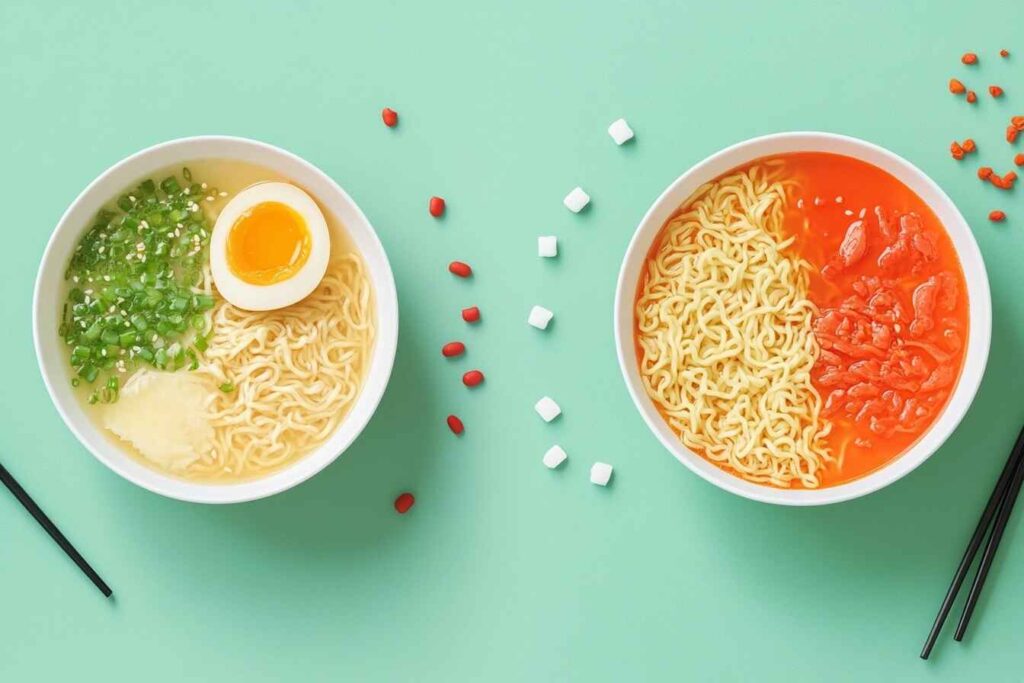
High Sodium Levels: A Major Concern
Sodium, the silent culprit, is one of the biggest concerns with instant ramen. Imagine this: the American Heart Association recommends no more than 2,300 mg of sodium per day. A single pack of ramen can account for 75–100% of that limit. Yikes! Too much sodium can lead to high blood pressure, heart problems, and even kidney issues.
Low Nutritional Density in Instant Ramen
Nutritional density refers to how much “bang for your buck” you get nutritionally per calorie. Unfortunately, instant ramen offers very little in this department. It’s high in calories and fats but lacks essential vitamins, minerals, and fiber. Think of it as empty calories wrapped in salty goodness.
Additives and Preservatives in Ramen
Preservatives like TBHQ and artificial flavors are a double-edged sword. While they extend shelf life and enhance taste, long-term consumption may have health risks. Studies suggest excessive TBHQ consumption might lead to nausea, dizziness, or even cellular damage over time.
Block Quote: “If instant ramen is your go-to comfort food, consider it a treat rather than a staple to avoid unnecessary exposure to harmful additives.”
Health Problems Associated with Excessive Ramen Consumption
Risk of Hypertension and Heart Diseases
Let’s get real – ramen’s high sodium content is like a ticking time bomb for your heart. Regularly consuming instant ramen can lead to elevated blood pressure levels, which increases the risk of heart disease and stroke. Think of it like this: you wouldn’t add a tablespoon of salt to your water, right? Yet, instant ramen packs almost that much sodium in a single serving!
Studies have shown that diets high in sodium are linked to hypertension (high blood pressure), which stresses the heart and arteries. If ramen is a daily indulgence, you might want to reconsider.
Digestive Issues from Additives
Ever feel bloated or uneasy after a bowl of instant ramen? You’re not alone. Additives like monosodium glutamate (MSG) and preservatives can wreak havoc on your digestive system. While MSG enhances flavor, some people are sensitive to it, experiencing symptoms like headaches, nausea, or abdominal discomfort – commonly referred to as “Chinese Restaurant Syndrome.”
But it doesn’t stop there. The processed nature of instant noodles means they’re harder to digest, potentially sitting in your stomach longer than fresh, homemade alternatives. It’s like asking your digestive system to run a marathon when all it signed up for was a light jog.
Impact on Weight and Metabolism
Here’s the kicker: instant ramen is calorie-dense and nutrient-poor. Consistently eating high-calorie foods without adequate nutrients can disrupt your metabolism, leading to weight gain. Imagine pouring sugar into a car’s gas tank – it’s going to mess things up, right? That’s how your body feels when it gets empty calories from instant noodles.
Moreover, the high levels of unhealthy fats in ramen, especially from fried noodles, can contribute to obesity and an increased risk of metabolic disorders like diabetes.
Debunking Myths: Is All Ramen Unhealthy?
Comparing Fresh Ramen to Instant Ramen
Not all ramen is created equal. Fresh ramen, especially when made from scratch, is in a league of its own. It’s like comparing a homemade pizza loaded with veggies to a frozen store-bought one. Fresh ramen uses high-quality, fresh ingredients and allows for better control over sodium and fat content.
For example, traditional Japanese ramen uses broths made from bones and vegetables simmered for hours, infusing nutrients like collagen and minerals. In contrast, instant ramen broth is often just flavored powder and oil – a far cry from the real deal.
| Category | Fresh Ramen | Instant Ramen |
|---|---|---|
| Broth | Rich in nutrients (e.g., collagen) | Processed, fried, or dehydrated |
| Noodles | Fresh, often handmade | Processed, fried or dehydrated |
| Toppings | Fresh vegetables, eggs, meats | Minimal or none |
Customizing Ramen for a Healthier Meal
Here’s a plot twist: even instant ramen can be made healthier with a few tweaks. Think of it as turning fast food into gourmet dining. Try these simple hacks:
- Add veggies: Spinach, carrots, or mushrooms can boost the fiber and vitamin content.
- Swap the flavor packet: Replace it with homemade stock or low-sodium alternatives.
- Include protein: Toss in a boiled egg, grilled chicken, or tofu for added sustenance.
How to Enjoy Ramen Responsibly
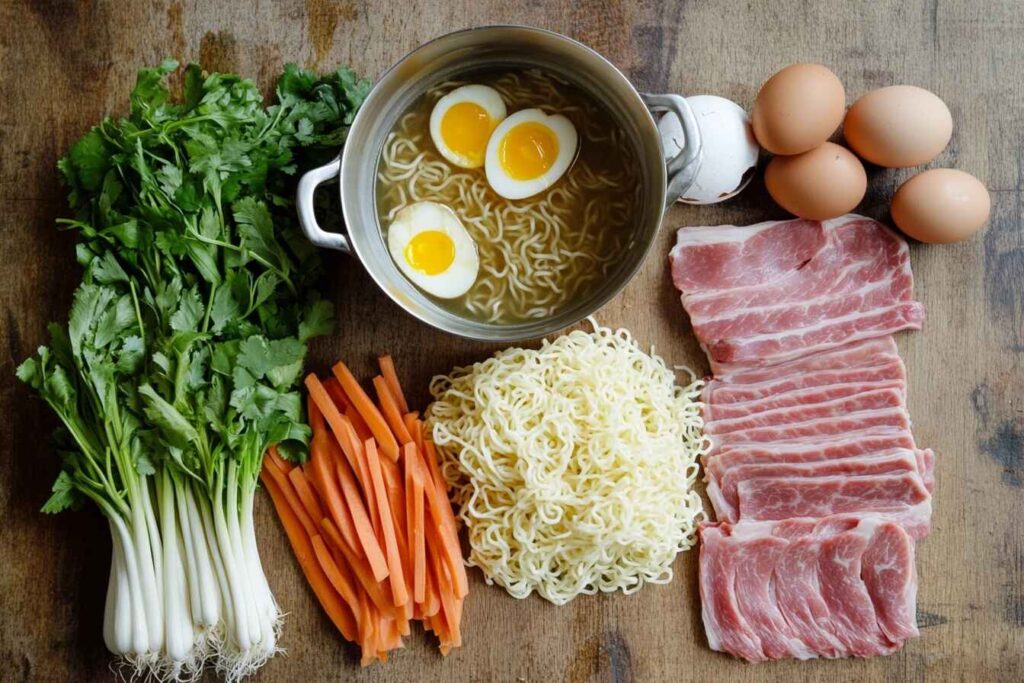
Balancing Sodium Levels in Your Bowl
If you love ramen but dread its sodium levels, there’s good news: you can take control. Dilute the broth with water or homemade stock to reduce the salt concentration. You can also add a splash of lemon juice – it cuts through the saltiness and adds a fresh zing.
Quick Tip: Opt for brands that offer “low-sodium” or “reduced-sodium” versions of instant noodles. They may not be perfect, but every little bit helps.
Adding Nutrient-Rich Ingredients
Think of your ramen bowl as a blank canvas. The more colorful the ingredients, the healthier it becomes. Here are some ideas:
- Vegetables: Add fresh or frozen greens like kale, spinach, or bok choy.
- Proteins: Eggs, lean meats, or plant-based proteins like edamame.
- Healthy Fats: A drizzle of sesame oil or a sprinkle of chia seeds for added nutrition.
Portion Control and Frequency of Consumption
The saying “everything in moderation” couldn’t be more true for ramen lovers. Enjoying instant ramen once in a while won’t derail your health. However, eating it daily is like walking a tightrope over a sea of health problems.
- Limit your serving size by sharing a pack or pairing it with a side salad.
- Treat ramen as an occasional indulgence rather than a daily staple.
Block Quote: “Ramen doesn’t have to be all-or-nothing. With a little creativity, you can enjoy its comforting flavors without compromising your health.”
Common Problems and Solutions for Ramen Lovers
Problem: Craving Ramen Too Frequently
Ever find yourself craving ramen more than you’d like to admit? It’s no surprise – the combination of salt, fat, and carbs is designed to hit all the pleasure centers in your brain. But overindulging can take a toll.
Solution: Exploring Alternatives with Similar Flavors
Craving ramen’s savory, umami-packed flavors? Try these healthier substitutes:
- Rice noodles in miso soup: Lower in sodium but just as satisfying.
- Zoodles (zucchini noodles): For a low-carb, veggie-packed twist.
- Homemade broth-based soups: Add fresh veggies and lean proteins.
Problem: Difficulty Finding Healthy Ramen Options
The supermarket aisle can feel like a minefield when you’re looking for healthier ramen options. Most instant varieties prioritize convenience over nutrition.
Solution: Homemade Ramen Recipes for Better Nutrition
Making ramen from scratch might sound intimidating, but it’s easier than you think. Start with a simple homemade broth (chicken, vegetable, or miso), add fresh noodles, and pile on the toppings. Not only is it healthier, but it also tastes way better!
The Cultural Significance of Ramen: Beyond Nutrition
Ramen as a Symbol of Japanese Cuisine
Ramen isn’t just a dish; it’s a cultural icon. In Japan, ramen shops are as common as coffee shops in the West. They’re places where people gather, unwind, and savor flavors that have been perfected over generations. Imagine walking down a bustling street in Tokyo, the aroma of simmering broth wafting through the air, inviting you into a cozy ramen-ya (ramen shop). 🍜
Ramen represents the Japanese spirit of “kaizen”, or continuous improvement. Chefs dedicate their lives to mastering the art of ramen, from crafting the perfect noodle texture to balancing the flavors of the broth. Each region in Japan boasts its own style – from the miso ramen of Hokkaido to the tonkatsu (pork bone broth) ramen of Kyushu.
Ramen in Pop Culture and Media
Ramen’s influence stretches far beyond the kitchen. It’s a staple in anime and manga, often depicted as the favorite food of beloved characters. Think of Naruto Uzumaki slurping down bowls of miso ramen – his enthusiasm mirrors that of real-life ramen enthusiasts!
Movies like “Tampopo” celebrate ramen’s cultural significance, showcasing it as more than just food but an experience that brings people together. Ramen festivals, museums, and even theme parks in Japan are dedicated to this humble noodle dish, highlighting its impact on society.
Final Verdict: Is Ramen Really Junk Food?
Factors to Consider Before Labeling Ramen
So, is ramen junk food? The answer isn’t black and white. It’s like asking if sandwiches are unhealthy – it depends on what’s inside them. Instant ramen, with its high sodium and preservatives, leans towards the junk food category. However, fresh ramen made with wholesome ingredients can be a nourishing meal.
Consider these factors:
- Ingredient Quality: Fresh vegetables, quality proteins, and homemade broths make a big difference.
- Preparation Method: Baking noodles instead of frying reduces unhealthy fats.
- Frequency of Consumption: Occasional indulgence is generally fine; daily consumption might be problematic.
Block Quote: “Labeling all ramen as junk food overlooks the dish’s rich diversity and potential for healthy preparation.”
Comparing Nutritional Facts: Instant vs. Fresh Ramen
Let’s take a closer look with a side-by-side comparison:
| Nutrient (Per Serving) | Instant Ramen | Fresh Ramen |
|---|---|---|
| Calories | 380 kcal | 500 kcal |
| Carbohydrates | 52 g | 60 g |
| Protein | 8 g | 20 g |
| Fat | 14 g | 12 g |
| Sodium | 1,800 mg 😱 | 900 mg 😊 |
| Fiber | 2 g | 5 g |
| Vitamins & Minerals | Low | High |
As you can see, fresh ramen tends to have more protein and fiber, and less sodium compared to instant ramen. Plus, it’s richer in essential vitamins and minerals, especially when loaded with veggies.
Striking a Balance Between Taste and Health
Here’s the good news: you don’t have to give up ramen to stay healthy. It’s all about balance and making smarter choices. Think of it like tuning a guitar – you need the right tension on each string to create harmony.
- Opt for Fresh or Low-Sodium Options: Choose fresh ramen when possible or look for low-sodium instant varieties.
- Customize Your Bowl: Load up on veggies and lean proteins to enhance nutrition.
- Mindful Eating: Savor your ramen slowly, appreciating the flavors and textures. This can lead to greater satisfaction with smaller portions.
Block Quote: “Enjoying ramen responsibly is like enjoying life’s pleasures in moderation – it’s all about making choices that make you feel good inside and out.”
Conclusion: Embracing Ramen with a Healthier Perspective
At the end of the day, ramen is more than just a meal; it’s a cultural experience that brings joy to many—labeling it strictly as junk food doesn’t do justice to its rich history and potential for nourishment.
Imagine ramen as a canvas – you have the power to create a masterpiece that’s both delicious and good for you. By making mindful choices, you can enjoy all the comforting flavors of ramen without compromising your health.
So go ahead, enjoy that bowl of ramen! Just remember, moderation and customization are key. After all, life’s too short not to enjoy the foods you love. 🍜❤️
